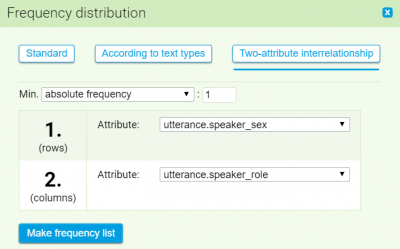Lesson 7: Two-attribute interrelationship frequency distribution
The KonText interface allows you to view the interrelations of two selected attributes (positional and structural). This property is described in detail in the general KonText manual.
To demonstrate using the OBC, we can look at the speakers who used the word bloody in the proceedings; specifically, their gender and their role at the court. To view the interrelation between these two attributes, a standard concordance needs to be created.
Make sure you have selected the OBC and using the basic query type, search for the word bloody. Click on Frequency in the top bar menu and select Custom. In the box, select Two-attribute interrelationship. Here you can adjust the minimal frequency value or percentile – to include all occurrences, select absolute frequency and type in 1. In the first row, select the attribute utterance.speaker_sex, while in the second row, select utterance.speaker_role. When you are satisfied with your selection, click on the Make frequency list button.
You will be presented with a table of results summarizing the number of occurrences within each category. You may switch the view mode between table and list of pairs, and you can switch the rows and columns to find which is more suitable. For advanced users, there are several additional options for specifying the data parameters and viewing, such as setting the confidence interval, row and column sorting etc.
You can click on the individual cells to view the information in detail; you may also view the filtered concordance, which will include only the occurrences in accordance to the specified attributes.
If you are ready, you can continue to the last lesson of this course.









